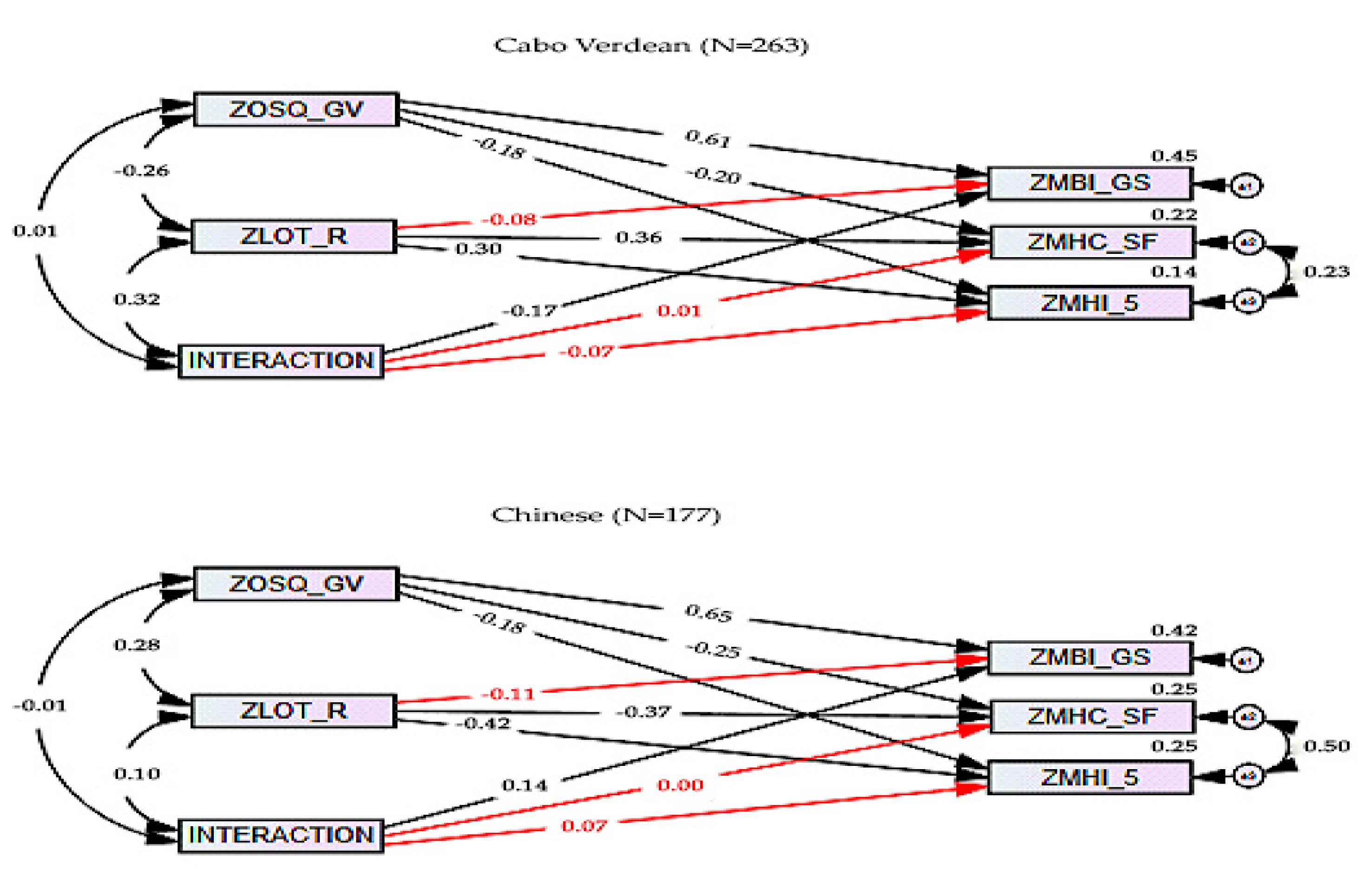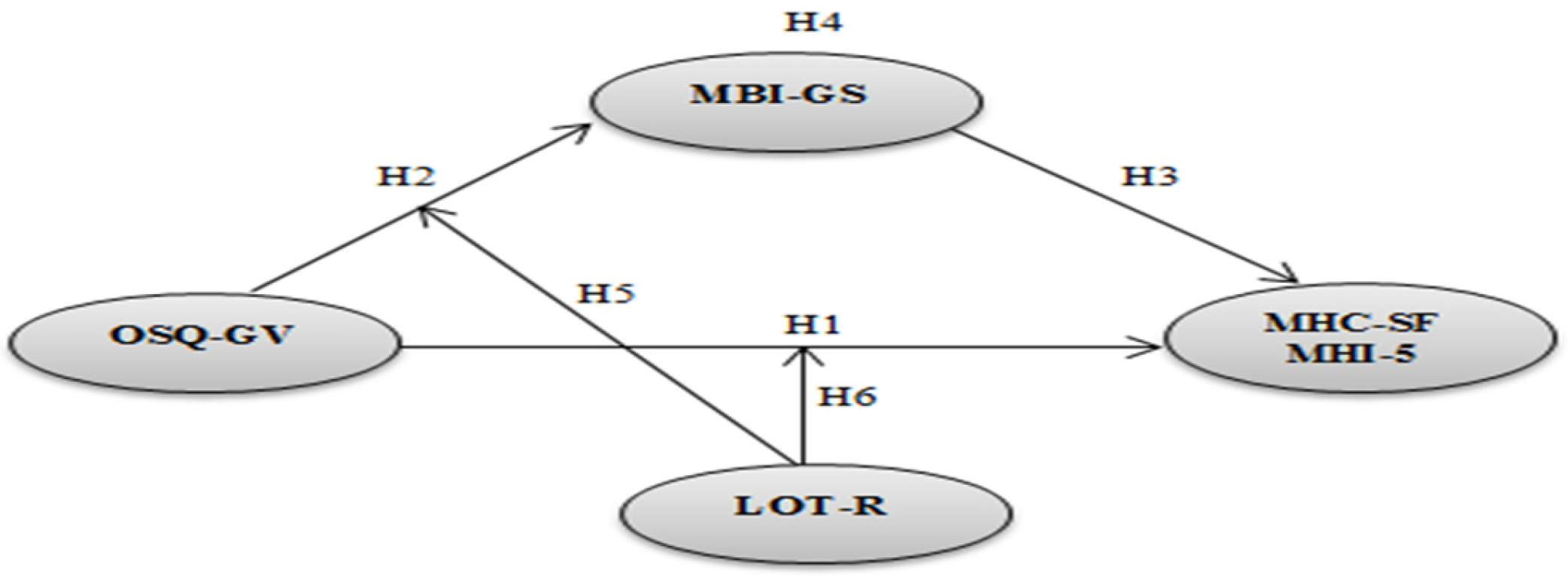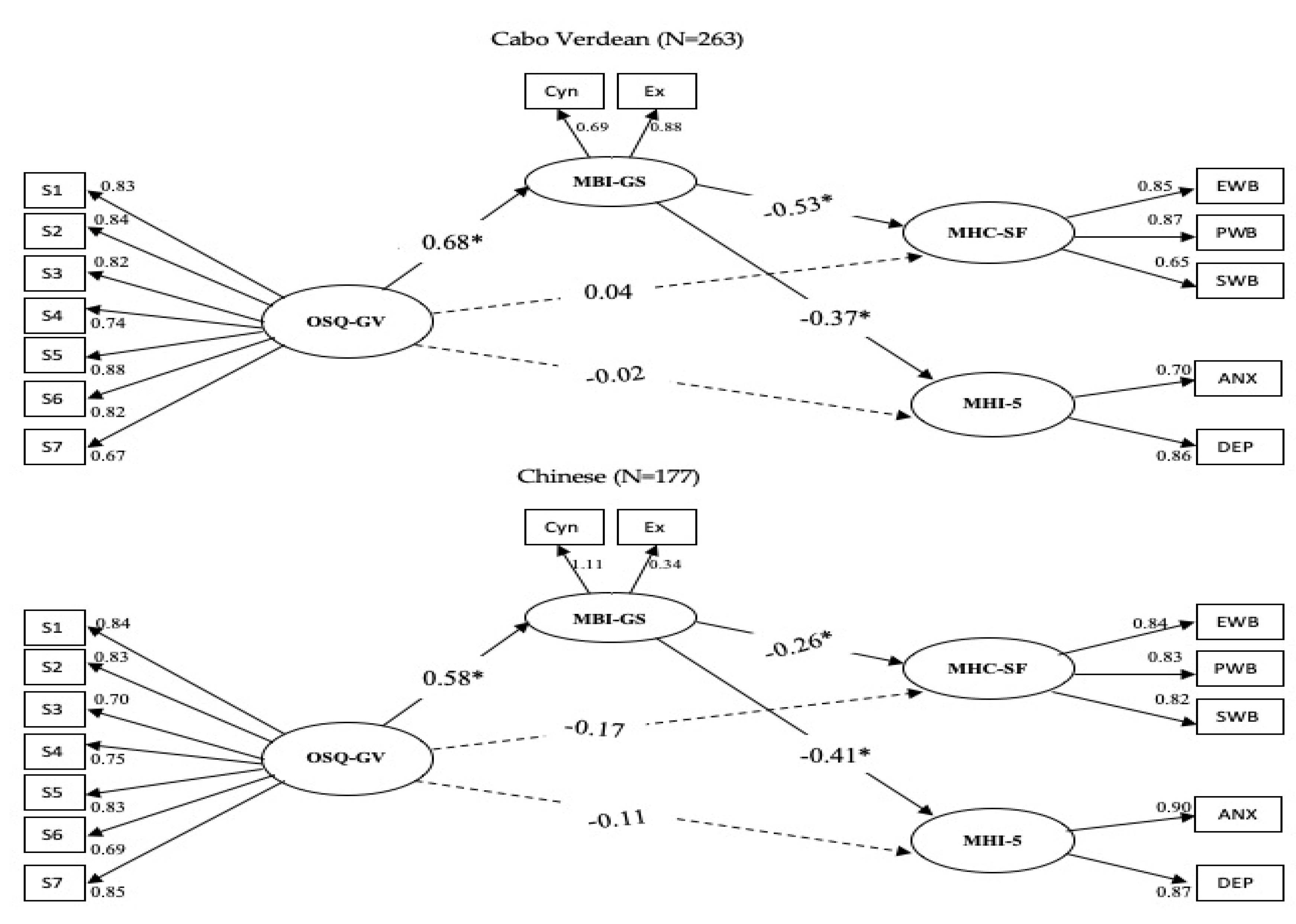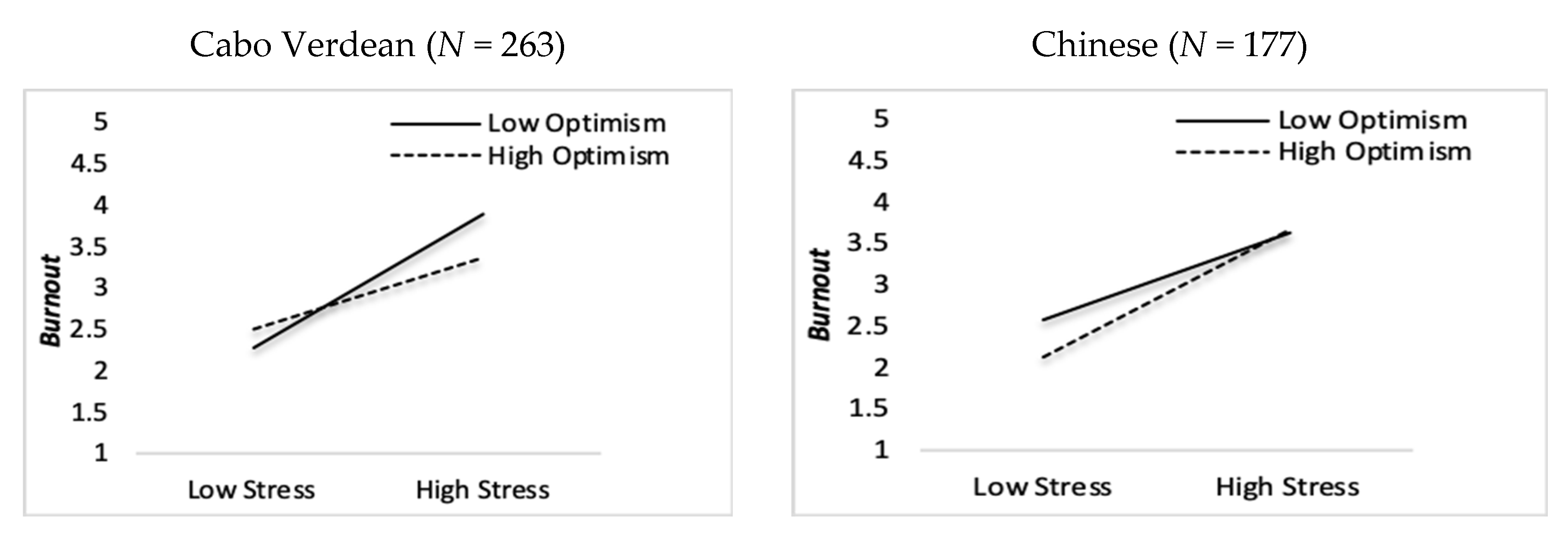Occupational Stress and Employees Complete Mental Health: A Cross-Cultural Empirical Study
Abstract
1. Introduction
1.1. Dual-Factor Model of Mental Health
1.2. Occupational Stress and Mental Health
1.3. Role of Burnout
1.4. Roles of Optimism
1.5. Cultural Context and Stress Management
1.6. Current Study
2. Materials and Methods
2.1. Participants
2.2. Measures
2.2.1. Occupational Stress
2.2.2. Positive Mental Health
2.2.3. Negative Mental Health
2.2.4. Burnout
2.2.5. Optimism
2.3. Procedure
2.4. Analytic Strategy
3. Results
3.1. Preliminary Analyses and Descriptive Statistics
3.2. Structural Equation Modelling Results
3.3. Mediation Effect of Burnout on Occupational Stress and Mental Health
3.4. Moderation Effect of Optimism
3.5. Differences between Occupational Stress and Complete Mental Health
4. Discussion
4.1. The Relationship Between Occupational Stress and Complete Mental Health
4.2. The Mediating and Moderating Roles of Burnout and Optimism
4.3. The Differences between Cabo Verdean and Chinese Employees
4.4. Strengths, Limitations and Future Directions
5. Conclusions
Author Contributions
Funding
Acknowledgments
Conflicts of Interest
Appendix A. Moderation Model of the Test Results

References
- International Labor Organization (ILO). Workplace Stress: A Collective Challenge; International Labor Office: Genève, Switzerland, 2016; ISBN 978-92-2-130641-2. [Google Scholar]
- Kahn, R.; Byosiere, P. Stress in Organizations. In Handbook of Industrial and Organizational Psychology, 2nd ed.; Dunnette, M., Hough, L., Eds.; Consulting Psychologists Press: Palo Alto, CA, USA, 1992; Volume 3, pp. 571–650. [Google Scholar]
- Murtaza, M.; Illzam, E.M.; Muniandy, R.K.; Hashmi, M.I.; Sharifa, A.M.; Nang, M.K. Causes and Prevention of Occupational Stress. J. Dent. Med. Sci. 2015, 14, 98–104. [Google Scholar] [CrossRef]
- Colligan, T.W.; Higgins, E.M. Workplace Stress Etiology and Consequences. J. Workplace Behav. Health 2006, 21, 89–97. [Google Scholar] [CrossRef]
- Kuper, H.; Marmot, M. Job strain, job demands, decision latitude, and risk of coronary heart disease within the Whitehall II study. J. Epidemiol. Commun. Health 2003, 57, 147–153. [Google Scholar] [CrossRef] [PubMed]
- Dollard, M.F.; Bakker, A.B. Psychosocial safety climate as a precursor to conducive work environments, psychological health problems, and employee engagement. J. Occup. Organ. Psychol. 2010, 83, 579–599. [Google Scholar] [CrossRef]
- Idris, M.A.; Dollard, M.F. Psychosocial safety climate, emotional demands, burnout, and depression: A longitudinal multilevel study in the Malaysian private sector. J. Occup. Health Psychol. 2014, 19, 291–302. [Google Scholar] [CrossRef] [PubMed]
- National Institute for Occupational Safety and Health (NIOSH). The Changing Organization of Work and the Safety and Health of Working People: Knowledge Gaps and Research Directions; DHHS Publication No. 2002-116; U.S. Government Printing: Washington, DC, USA, 2002. [Google Scholar]
- Stress and Well-being at Work. In APA Handbook of Industrial and Organizational Psychology; Clarke, S., Griffin, M.A., Zedeck, S., Eds.; American Psychological Association: Washington, DC, USA, 2011; Volume 3, pp. 359–397. [Google Scholar] [CrossRef]
- European Agency for Safety and Health at Work EU-OSHA. Psychosocial Risks and Stress at Work: European Opinion Polls on Safety and Health at Work. Available online: File:///Users/mac/Desktop/FILHASS/%20-%20Safety%20and%20health%20at%20work%20-%20EU-OSHA.webarchive (accessed on 10 January 2020).
- American Institute of Stress. Worrying Workplace Stress Statistics. Available online: File:///Users/mac/Desktop/FILHASS/Workplace%20Stress%20Statistics%20-%20The%20American%20Institute%20of%20Stress.webarchive (accessed on 15 January 2020).
- LaMontagne, A.D.; Martin, A.; Page, K.M.; Reavley, N.; Noblet, A.J.; Milner, A.; Keegel, T.; Smith, P.M. Workplace mental health: Developing an integrated intervention approach. BMC Psychiatry 2014, 14, 131. [Google Scholar] [CrossRef]
- Wang, Z.; Liu, H.; Yu, H.; Wu, Y.; Chang, S.; Wang, L. Associations between occupational stress, burnout and well-being among manufacturing workers: Mediating roles of psychological capital and self-esteem. BMC Psychiatry 2017, 17, 364. [Google Scholar] [CrossRef]
- Fila, M.J.; Wilson, M.S. Understanding Cross-Cultural Differences in the Work Stress Process: A Review and Theoretical Model. 2018. Available online: https://www.researchgate.net/publication/323955278_Understanding_CrossCultural_Differences_in_the_Work_Stress_Process_A_Review_and_Theoretical_Model (accessed on 27 January 2020).
- Ding, Y.; Qu, J.; Yu, X.; Wang, S. The Mediating Effects of Burnout on the Relationship between Anxiety Symptoms and Occupational Stress among Community Healthcare Workers in China: A Cross-Sectional Study. PLoS ONE 2014, 9, e107130. [Google Scholar] [CrossRef]
- Ragesh, G.; Tharayil, H.M.; Raj, T.P.M.; Philip, M.; Hamza, A. Occupational stress among police personnel in India. Open J. Psychiatry Allied Sci. 2017, 8, 148. [Google Scholar] [CrossRef]
- Malek, M.D.A.; Mearns, K.; Flin, R. Stress and psychological well-being in UK and Malaysian fire fighters. Cross Cult. Manag. Int. J. 2010, 17, 50–61. [Google Scholar] [CrossRef]
- Shen, X.; Yang, Y.-L.; Wang, Y.; Liu, L.; Wang, S.; Wang, L. The association between occupational stress and depressive symptoms and the mediating role of psychological capital among Chinese university teachers: A cross-sectional study. BMC Psychiatry 2014, 14, 329. [Google Scholar] [CrossRef] [PubMed]
- Lee, J.; Henning, R.; Cherniack, M. Correction Workers’ Burnout and Outcomes: A Bayesian Network Approach. Int. J. Environ. Res. Public Health 2019, 16, 282. [Google Scholar] [CrossRef] [PubMed]
- Burke, R. Workplace stress and well-being across cultures: Research and practice. Cross Cult. Manag. Int. J. 2010, 17, 5–9. [Google Scholar] [CrossRef]
- Smith, N.D.W. An Application of the Dual Factor Model of Mental Health in Elementary School Students: Implications for Social Functioning and Psychopathology. Bachelor’s Thesis, University of South Florida, Tampa, FL, USA, 2018. Available online: http://scholarcommons.usf.edu/etd/7231 (accessed on 19 January 2020).
- Greenspoon, P.J.; Saklofske, D.H. Toward an integration of subjective well-being and psychopathology. Soc. Indic. Res. 2001, 54, 81–108. [Google Scholar] [CrossRef]
- Seligman, M.E.P.; Csikszentmihalyi, M. (Eds.) Positive Psychology—An Introduction. Am. Psychol. 2000, 55, 5–14. [Google Scholar] [CrossRef]
- World Health Organization. Strengthening Mental Health Promotion; WHO: Geneva, Switzerland, 2011. [Google Scholar]
- Mental Health Foundation. Relationships in the 21st Century; Mental Health Foundation: London, UK, 2016. [Google Scholar]
- Keyes, C.L.M. Mental illness and/or mental health? Investigating axioms of the complete state model of health. J. Consult. Clin. Psychol. 2005, 73, 539–548. [Google Scholar] [CrossRef]
- Suldo, S.M.; Shaffer, E.J. looking beyond psychopathology: The dual factor model of mental health in youth. School Psychol. Rev. 2008, 37, 52–68. [Google Scholar]
- Yaacob, M.; Long, C.S. Role of Occupational Stress on Job Satisfaction. Mediterr. J. Soc. Sci. 2015, 6, 2. [Google Scholar] [CrossRef]
- Mark, G.; Smith, A.P. Occupational stress, job characteristics, coping, and the mental health of nurses. Br. J. Health Psychol. 2012, 17, 505–521. [Google Scholar] [CrossRef]
- DiGiacomo, M.; Adamson, B. Coping with stress in the workplace: Implications for new health professionals. J. Allied Health 2001, 30, 106–111. [Google Scholar]
- Mensah, J.; Amponsah-Tawiah, K. Mitigating occupational stress: The role of psychological capital. J. Workplace Behav. Health 2016, 4, 189–203. [Google Scholar] [CrossRef]
- Suleman, Q.; Hussain, I.; Shehzad, S.; Syed, M.A.; Raja, S.A. Relationship between perceived occupational stress and psychological well-being among secondary school heads in Khyber Pakhtunkhwa, Pakistan. PLoS ONE 2018, 13, e0208143 . [Google Scholar] [CrossRef] [PubMed]
- Banerjee, P. Relationship between perceived psychological stress and depression: Testing moderating effect of dispositional optimism. J. Workplace Behav. Health 2012, 27, 32–46. [Google Scholar] [CrossRef]
- Nakao, M. Work-related stress and psychosomatic medicine. Biopsyosoc. Med. 2010, 4, 4–11. [Google Scholar] [CrossRef] [PubMed]
- Maslach, C.; Jackson, S.; Leiter, M. Maslach burnout inventory manual. Consul. Phycol. Press 1996, 3, 3–9. [Google Scholar]
- Wang, Y.; Ramos, A.; Wu, H.; Liu, L.; Yang, X.; Wang, J.; Wang, L. Relationship between occupational stress and burnout among Chinese teachers: A cross-sectional survey in Liaoning, China. Int. Arch. Occup. Environ. Health 2015, 88, 589–597. [Google Scholar] [CrossRef]
- Hayes, C.; Weathington, B. Optimism, stress, life satisfaction, and job burnout in restaurant managers. J. Psychol. 2007, 14, 565–579. [Google Scholar] [CrossRef]
- Chen, J.; Li, J.; Cao, B.; Wang, F.; Luo, L.; Xu, J. Mediating effects of self-efficacy, coping, burnout, and social support between job stress and mental health among young Chinese nurses. J. Adv. Nurs. 2020, 76, 163–173. [Google Scholar] [CrossRef]
- Shkoler, O.; Tziner, A. The mediating and moderating role of burnout and emotional intelligence in the relationship between organizational justice and work misbehavior. J. Work Organ. Psychol. 2017, 33, 157–164. [Google Scholar] [CrossRef]
- Panchal, S.; Mukherjee, S.; Kumar, U. Optimism in relation to well-being, resilience, and perceived stress. Int. J. Educ. Psychol. Res. 2016, 5, 1–6. [Google Scholar]
- Burke, K.L.; Joyner, A.B.; Czech, D.R.; Wilson, M.J. An Investigation of Concurrent Validity between Two Optimism/Pessimism Questionnaires: The Life Orientation Test-Revised and the Optimism/Pessimism Scale. Curr. Psychol. 2000, 129–136. [Google Scholar] [CrossRef]
- Caprara, G.V.; Fagnani, C.; Alessandri, G.; Steca, P.; Gigantesco, A.; Sforza, L.L.C.; Stazi, M.A. Human optimal functioning: The genetics of positive orientation towards self, life, and the future. Behav. Genet. 2009, 39, 277–284. [Google Scholar] [CrossRef] [PubMed]
- Carver, C.S.; Scheier, M.F.; Segerstrom, S.C. Optimism. Clin. Psychol. Rev. 2010, 30, 879–889. [Google Scholar] [CrossRef] [PubMed]
- Steginga, S.K.; Occhipinti, S. Dispositional optimism as a predictor of men’s decision-related distress after localized prostate cancer. Health Psychol. 2006, 25, 135–143. [Google Scholar] [CrossRef]
- Kim, E.; Park, N.; Peterson, C. Dispositional optimism protects older adults from stroke: The health and retirement study. Stroke J. Cereb. Circ. 2011, 42, 2855–2859. [Google Scholar] [CrossRef]
- Makikangas, A.; Kinnunen, U. Psychosocial Work Stressors and Wellbeing: Self Esteem and Optimism as Moderators in a Year-Long Longitudinal Sample. Personal. Ind. Differ. 2003, 35, 537–557. [Google Scholar] [CrossRef]
- Demenouti, E.; Bakker, A.B.; Nachreniner, F.; Schaufeli, W.B. The Job Demands: Resources model of burnout. J. Appl. Psychol. 2001, 86, 499–512. [Google Scholar] [CrossRef]
- Chang, E.C. Does dispositional optimism moderate the relation between perceived stress and psychological well-being? A preliminary investigation. Personal. Ind. Differ. Cult. Manag. 1998, 25, 233–240. [Google Scholar] [CrossRef]
- Romswinkel, E.V.; König, H.-H.; Hajek, A. The role of optimism in the relationship between job stress and depressive symptoms. Longitudinal findings from the German Ageing Survey. J. Affect. Disord. 2018, 241, 249–255. [Google Scholar] [CrossRef]
- Riolli, L.T.; Savicki, V. Optimism and coping as moderators of the relationship between chronic stress and burnout. Psychol. Rep. 2003, 92, 1215–1226. [Google Scholar] [CrossRef]
- Chang, E.C. Cultural differences in optimism, pessimism, and coping: Predictors of subsequent adjustment in Asian American and Caucasian American college students. J. Couns. Psychol. 1996, 43, 113–123. [Google Scholar] [CrossRef]
- Lai, J.C.L.; Yue, X. Measuring optimism in Hong Kong and mainland Chinese with the revised Life Orientation Test. Personal. Ind. Differ. 2000, 28, 781–796. [Google Scholar] [CrossRef]
- Pasca, R.; Wagner, S.L. Occupational Stress, Mental Health and Satisfaction in the Canadian Multicultural Workplace. Soc. Indic. Res. 2012, 109, 377–393. [Google Scholar] [CrossRef]
- Xie, J.L. Karasek’s model in the People’s Republic of China: Effects of job demands, control, and individual differences. Acad. Manag. J. 1996, 39, 1594–1618. [Google Scholar]
- Seth Oppong Overcoming obstacles to a truly global psychological theory, research, and praxis in Africa. J. Psychol. Afr. 2019, 29, 292–300. [CrossRef]
- Frontiers Media. African Cultural Models in Psychology. Available online: https://www.frontiersin.org/research-topics/9905/african-cultural-models-in-psychology (accessed on 20 December 2019).
- Siu, O.-l.; Spector, P.E.; Cooper, C.; Lu, C.-q. Work Stress, Self-Efficacy, Chinese Work Values, and Work Well-Being in Hong Kong and Beijing. Int. J. Stress Manag. 2005, 12, 274–288. [Google Scholar] [CrossRef]
- Yew, S.-H.; Lim, M.-J.K.; Haw, Y.-X.; Gan, S.K.-E. The Association between Perceived Stress, Life Satisfaction, Optimism, and Physical Health in the Singapore Asian context. Asian J. Humanit. Soc. Sci. 2015, 3, 2320–9720. [Google Scholar]
- Aldwin, C.M. Culture, Coping and Resilience to Stress. Available online: https://www.researchgate.net/publication/241639325_Culture_Coping_and_Resilience_to_Stress (accessed on 11 February 2020).
- Ahmad Dar. W. Cross-cultural understanding of stress and coping mechanisms. Int. J. Res. Eng. IT Soc. Sci. 2017, 7, 75–80. [Google Scholar]
- Triandis, H.C.; Suh, E.M. Cultural Influences on Personality. Annu. Rev. Psychol. 2002, 53, 133–160. [Google Scholar] [CrossRef]
- Hofstede, G.H. Culture and organizations. Int. Stud. Manag. Organ. 1980, 10, 15–41. [Google Scholar] [CrossRef]
- Shiraev, E.B.; Levy, D. Cross-Cultural Psychology: Critical Thinking and Contemporary Applications; Routledge: New York, NY, USA, 2016. [Google Scholar]
- Gomes, A.R. Questionário de Stresse Ocupacional – Versão Geral (QSO-VG). Relatório técnico não publicado (Occupational Stress Questionnaire - General Version (QSO-GV); Unpublished Technical Report; Universidade do Minho: Braga, Portugal, 2010. [Google Scholar]
- McHorney, C.A.; Ware, J.E., Jr. Construction and validation of an alternate form general mental health scale for the Medical Outcomes Study Short-Form 36-Item Health Survey. Med. Care. 1995, 33, 15–28. [Google Scholar] [CrossRef] [PubMed]
- Ware, J.E.; Snow, K.K.; Kosinski, M.; Gandek, B. SF-36 Health Survey Manual and Interpretation Guide; The Health Institute, New England Medical Center: Boston, MA, USA, 1993. [Google Scholar]
- Schaufeli, W.B.; Leiter, M.P.; Maslach, C.; Jackson, S.E. The MBI-General Survey. In Maslach Burnout Inventory Manual, 3rd ed.; Maslach, C., Jackson, S.E., Leiter, M.P., Eds.; Consulting Psychologists Press: Palo Alto, CA, USA, 1996. [Google Scholar]
- Scheier, M.F.; Carver, C.S.; Bridges, M.W. Distinguishing optimism from neuroticism (and trait anxiety, self-mastery, and self-esteem): A reevaluation of the Life Orientation Test. J. Personal. Soc. Psychol. 1994, 67, 1063–1078. [Google Scholar] [CrossRef]
- Anderson, J.C.; Gerbing, D.W. Structural equation modeling in practice: A review and recommended two-step approach. Psychol. Bull. 1998, 103, 411–423. [Google Scholar] [CrossRef]
- Hoyle, R.H. Structural Equation Modeling: Concepts, Issues, and Applications; Sage Publications: Thousand Oaks, CA, USA, 1995. [Google Scholar]
- Brown, T.A. Confirmatory Factor Analysis for Applied Research; The Guilford Press: New York, NY, USA, 2006. [Google Scholar]
- Hu, L.T.; Bentler, P.M. Cut off criteria for fit indexes in covariance structure analysis: Conventional criteria versus new alternatives. Struct. Equ. Model. 1999, 6, 1–55. [Google Scholar] [CrossRef]
- Byrne, B. Structural Equation Modeling with AMOS: Basic Concepts, Applications, and Programming; Lawrence Erlbaum: Mahwah, NJ, USA, 2001. [Google Scholar]
- MacKinnon, D.P. Introduction to Statistical Mediation Analysis; Erlbaum: Mahwah, NJ, USA, 2008. [Google Scholar]
- Muthén, B.; Kaplan, D. A comparison of some methodologies for the factor analysis of non-normal likert variables: A note on the size of the model. Br. J. Math. Stat. Psychol. 1992, 45, 19–30. [Google Scholar] [CrossRef]
- Curran, P.J.; West, S.G.; Finch, J.F. The robustness of test statistics to nonormality and specification error in confirmatory factor analysis. Psychol. Methods 1996, 1, 16–29. [Google Scholar] [CrossRef]
- Shrout, P.E.; Bolger, N. Mediation in experimental and non- experimental studies: New procedures and recommendations. Psychol. Methods 2002, 7, 442–445. [Google Scholar] [CrossRef]
- Jamal, M. Burnout among Canadian and Chinese employees: A cross-cultural study. Eur. Manag. Rev. 2005, 2, 224–230. [Google Scholar] [CrossRef]
- Shigemi, J.; Mino, Y.; Tsuda, T.; Babazono, A.; Aoyama, H. The relationship between job stress and mental health at work. Ind. Health 1997, 35, 29–35. [Google Scholar] [CrossRef]
- Akintayo, D.I. Occupational stress, psychological well-being and workers’ behavior in manufacturing industries in south-west Nigeria. Resear. J. Organ. Psychol. Educ. Stud. 2012, 1, 289–294. [Google Scholar]
- Damásio, B.; Borsa, J.C.; Koller, S.H. Adaptation and Psychometric Properties of the Brazilian Version of the Five-item Mental Health Index (MHI-5). Psicologia Reflexao e Crítica 2014, 27, 323–330. [Google Scholar] [CrossRef]
- Marques, S.C.; Pais-Ribeiro, J.L.; Lopez, S.J. Use of the “Mental Health Inventory – 5” with Portuguese 10-15 years old. Span. J. Psychol. 2011, 14, 478–485. [Google Scholar] [CrossRef] [PubMed]
- Gao, Y.-Q.; Pan, B.-C.; Sun, W.; Wu, H.; Wang, J.-N.; Wang, L. Depressive symptoms among Chinese nurses: Prevalence and the associated factors. J. Adv. Nurs. 2011, 68, 1166–1175. [Google Scholar] [CrossRef] [PubMed]



| Cabo Verdean Employees (N = 263) | Chinese Employees (177) | ||||
|---|---|---|---|---|---|
| Variables | N | % | Variables | N | % |
| Gender | Gender | ||||
| male | 188 | 71.5 | male | 77 | 43.5 |
| female | 75 | 28.5 | female | 100 | 56.5 |
| Age | Age | ||||
| 20–29 years old | 37 | 14.1 | 20–29 years old | 104 | 58.4 |
| 30–39 years old | 164 | 62.4 | 30–39 years old | 39 | 22.0 |
| 40–49 years old | 55 | 20.9 | 40–49 years old | 20 | 11.2 |
| 50 years old | 7 | 2.7 | 50 years old | 11 | 6.2 |
| Marital status | Marital status | ||||
| married | 49 | 18.6 | married | 73 | 41.6 |
| divorced | 7 | 2.7 | divorced | 6 | 3.3 |
| single | 207 | 78.7 | single | 98 | 53.3 |
| Education level | Education level | ||||
| university degree | 130 | 49.4 | university degree | 139 | 78.6 |
| high school degree | 133 | 50.6 | high school degree | 38 | 21.4 |
| Work year | Work year | ||||
| 1–5 | 51 | 19.4 | 1–5 | 100 | 56.5 |
| 6–10 | 73 | 27.8 | 6–10 | 33 | 18.7 |
| 11–20 | 119 | 45.2 | 11–20 | 22 | 12.4 |
| more than 20 | 20 | 7.6 | more than 20 | 22 | 12.4 |
| Weekly work time | Weekly work time | ||||
| 40 h | 73 | 27.8 | 40 h | 94 | 53.1 |
| more than 40 h | 190 | 72.2 | more than 40 h | 83 | 46.9 |
| Variables | α | MD | SD | Skew | Kurt | 1 | 2 | 3 | 4 |
|---|---|---|---|---|---|---|---|---|---|
| Cabo Verde | |||||||||
| OSQ—GV | 0.93 | 2.10 | 0.74 | −0.17 | −0.51 | - | |||
| LOT-R | 0.86/67 | 18.6 | 3.92 | −0.58 | 0.36 | −0.26 ** | - | ||
| MHC—SF | 0.89 | 12.3 | 2.39 | −0.12 | −0.47 | −0.30 ** | 0.42 ** | - | |
| MHI-5 | 0.79 | 3.58 | 0.77 | −0.27 | −0.45 | −0.25 ** | 0.32 ** | 0.36 ** | - |
| MBI-GS | 0.72 | 2.72 | 0.61 | 0.39 | 0.43 | 0.63 ** | −0.29 ** | −0.22 ** | −0.30 ** |
| China | |||||||||
| OSQ—GV | 0.94 | 2.94 | 0.71 | 0.21 | 0.67 | - | |||
| LOT-R | 0.75/67 | 2.69 | 0.53 | 0.31 | 1.00 | 0.27 ** | - | ||
| MHC—SF | 0.94 | 15.9 | 3.71 | −0.20 | −0.02 | −0.35 ** | −0.43 ** | - | |
| MHI-5 | 0.79 | 3.91 | 1.04 | −0.14 | −0.33 | −0.29 ** | −0.46 ** | 0.62 ** | - |
| MBI-GS | 0.87 | 4.14 | 0.85 | −0.14 | 2.5 | 0.62 ** | 0.08 | −0.27 ** | −0.14 * |
| Model Pathways | β Standardized Indirect Effect | 95% CI Indirect Effect | ||
|---|---|---|---|---|
| Lower | Upper | p-Value | ||
| Cabo Verdean | ||||
| OSQ—GV← MBI-GS ←MHC—SF | −0.360 | −0.778 | −0.017 | 0.002 |
| OSQ—GV ← MBI-GS ← MHI-5 | −0.249 | −0.645 | −0.034 | 0.028 |
| Chinese | ||||
| OSQ—GV ← MBI-GS ← MHC—SF | −0.153 | −0.254 | −0.005 | 047 |
| OSQ—GV ← MBI-GS ← MHI-5 | −0.240 | −0.511 | −0.055 | 004 |
| Variables | Cabo Verdean | Chinese | Independent t-test Values | |
|---|---|---|---|---|
| Mean (S.D.) | Mean (S.D.) | Difference in Mean | t-Value | |
| Relationship with clients | 7.93 (3.61) | 11.3 (3.43) | −3.44 | −9.99 ** |
| Relationship with supervisor | 7.07 (2.62) | 8.32 (2.94) | −124 | −4.63 ** |
| Relationship with colleagues | 6.36 (2.58) | 7.63 (2.53) | −1.27 | −5.12 ** |
| Work overload | 21.6 (2.94) | 12.3 (4.05) | 9.29 | 27.8 ** |
| Career and remuneration | 9.16 (3.23) | 12.7 (3.22) | −3.62 | −11.5 ** |
| Family problems | 6.89 (2,75) | 8.85 (2.93) | −1.95 | −7.13 ** |
| Working conditions | 5.48 (2.58) | 8.62 (2.56) | −3.14 | −12.5 ** |
| Exhaustion–energy | 10.8 (6.33) | 20.1 (6.18) | −9.23 | −15.1 ** |
| Cynicism–involvement | 4.57 (4.36) | 20.9 (4.51) | −16.3 | −38 ** |
| Professional efficacy | 21.3 (3.85) | 21.0 (4.84) | 0.31 | 0.75 |
| Psychological well-being | 4.35 (0.99) | 11.4 (3.74) | −7.09 | −29.2 ** |
| Social well-being | 3.60 (0.98) | 18.7 (5.80) | −15.1 | −41.3 ** |
| Emotional well-being | 4.37 (0.80) | 24.6 (2.37) | −20.2 | −48.4 ** |
| Anxiety | 6.97 (1.78) | 6.29 (1.54) | 0.67 | 4.12 ** |
| Depression | 10.9 (2.55) | 9.62 (6.71) | 1.30 | 5.41 ** |
| Scales | ||||
| OSQ—GV | 2.10 (0.74) | 2.94 (0.71) | −0.84 | −11.8 ** |
| MBI-GS | 2.72 (0.61) | 4.14 (0.85) | −1.41 | −20 ** |
| LOT-R | 9.90 (2.33) | 2.69 (0.53) | 7.20 | 40.4 ** |
| MHC—SF | 12.3 (2.39) | 15.9 (3.71) | −3.58 | −12.3 ** |
| MHI-5 | 3.58 (0.77) | 3.91 (1.04) | −0.33 | −3.82 ** |
© 2020 by the authors. Licensee MDPI, Basel, Switzerland. This article is an open access article distributed under the terms and conditions of the Creative Commons Attribution (CC BY) license (http://creativecommons.org/licenses/by/4.0/).
Share and Cite
Moreno Fortes, A.; Tian, L.; Huebner, E.S. Occupational Stress and Employees Complete Mental Health: A Cross-Cultural Empirical Study. Int. J. Environ. Res. Public Health 2020, 17, 3629. https://doi.org/10.3390/ijerph17103629
Moreno Fortes A, Tian L, Huebner ES. Occupational Stress and Employees Complete Mental Health: A Cross-Cultural Empirical Study. International Journal of Environmental Research and Public Health. 2020; 17(10):3629. https://doi.org/10.3390/ijerph17103629
Chicago/Turabian StyleMoreno Fortes, Alcides, Lili Tian, and E. Scott Huebner. 2020. "Occupational Stress and Employees Complete Mental Health: A Cross-Cultural Empirical Study" International Journal of Environmental Research and Public Health 17, no. 10: 3629. https://doi.org/10.3390/ijerph17103629
APA StyleMoreno Fortes, A., Tian, L., & Huebner, E. S. (2020). Occupational Stress and Employees Complete Mental Health: A Cross-Cultural Empirical Study. International Journal of Environmental Research and Public Health, 17(10), 3629. https://doi.org/10.3390/ijerph17103629




